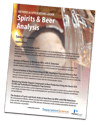Applications eBook
 Complete the form on the right to download your personal copy of the 'Spirits & Beer Analysis' eBook. This 49-page publication covers the applications detailed below.
Complete the form on the right to download your personal copy of the 'Spirits & Beer Analysis' eBook. This 49-page publication covers the applications detailed below.
Applications
 Aroma Study of Potable Spirits
Aroma Study of Potable Spirits
The production of whisky requires maturation in wooden casks for the full development of the finished product’s character. Subtle differences in the casks’ conditioning can produce quite different flavors and aromas that require skillful blending to achieve a consistent product. In this application note, the VOCs in single malt whisky were investigated.
 Analysis of Phenols in Whisky by HPLC with FL Detection
Analysis of Phenols in Whisky by HPLC with FL Detection
This application focuses on the HPLC separation and quantitation of ten phenols in three store-bought Scotch whiskies. Method conditions and performance data, including linearity and repeatability are presented.
 Characterization of Hop Aroma Using GC/MS, Headspace Trap and Olfactory Port
Characterization of Hop Aroma Using GC/MS, Headspace Trap and Olfactory Port
This application note describes a system that is able to provide both an objective chemical analysis of hop aroma using gas chromatography/mass spectrometry and, at the same time, provide the means for the user to monitor the olfactory character of each component as it elutes from the chromatographic column.

Monitoring Volatile Organic Compounds in Beer Production Using the Clarus SQ 8 GC/MS and TurboMatrix Headspace Trap Systems
This application note describes a system comprising a headspace trap sampler to extract and concentrate VOCs from a beer sample and deliver them to a gas chromatograph/mass spectrometer (GC/MS) for separation, identification and quantification.

The Analysis of Lactic and Acetic Acids in Sour Beers by HPLC with PDA Detection
This work pursued an effective, efficient and robust HPLC method for the quantitative analysis of lactic and acetic acid in beers by HPLC with photodiode array (PDA) detection. Performance results, including repeatability, linearity and limits of detection, are provided.

Simultaneous Determination of Pesticides Residues and Illegal Additives in Wine
In this study, a simple and sensitive LC-MS/MS method has been developed and applied for the determination of both pesticides and pigments in a single analytical run.
Method Descriptions

Perten Instruments Method Description - (Rapid Visco Analyer)
RVA Method 16.04 - Kilned Malt Method
This application describes the use of an RVA to rapidly estimate the quality potential of a finished malt.

Perten Instruments Method Description - (Rapid Visco Analyer)
RVA Method 17.04 -Brewing Adjuncts Method
This application describes the use of an RVA to assess the effect of added ingredients on the mashing behavior of a malt.

Perten Instruments Method Description - (Rapid Visco Analyer)
RVA Method 38.01 - Mash Viscosity Characterization in Brewing Method
This procedure is based on the method of Goode et al. (2005) using malted and unmalted barley, to study the effect of endogenous enzyme and added adjunct levels, respectively, on mash viscosity.
Case Studies

Long Trail Brewing Uses Headspace Sampling to Improve Beer Taste and Production Efficiency
This case study demonstrates how a microbrewery uses headspace sampling to monitor the taste of its beer and ensure that its process is working correctly.

Tsingtao Utilizes Headspace Sampling to Ensure World-Class Beer Quality Standards
This case study demonstrates how Tsingtao worked with PerkinElmer technical staff in China to select the best instruments and methodologies to maintain the stability and uniform quality of Tsingtao’s products.
To view the eBook complete the form on the right.
Sponsor:


